Monthly Archives: April 2022
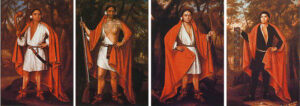 The New World (later the United States of America) was a pretty rough place in 1710. Great Britain owned a small portion of the whole of the New World, and the rest was often vied for against the French and other nations. That year, the mayor of Albany, New York, Pieter Schuyler, arranged a meeting between Queen Anne and five Indian Kings who wanted to request her aid, militarily. The Four Indian Kings or Four Kings of the New World were three Mohawk chiefs from one of the Five Nations of the Iroquois Confederacy and a Mahican of the Algonquian peoples. Five chiefs set out on the journey, but one died in mid-Atlantic. The three Mohawk Kings were Sa Ga Yeath Qua Pieth Tow of the Bear Clan, called King of Maquas, with the Christian name Peter Brant (grandfather of Mohawk leader Joseph Brant); Ho Nee Yeath Taw No Row of the Wolf Clan, called King of Canajoharie (“Great Boiling Pot”), or John of Canajoharie; and Tee Yee Ho Ga Row, meaning “Double Life”, of the Wolf Clan, also called Hendrick Tejonihokarawa or King Hendrick. The Mahican chief was Etow Oh Koam of the Turtle Clan, mistakenly identified in his portrait as Emperor of the Six Nations. The Algonquian-speaking Mahican people were not part of the Iroquois Confederacy.
The New World (later the United States of America) was a pretty rough place in 1710. Great Britain owned a small portion of the whole of the New World, and the rest was often vied for against the French and other nations. That year, the mayor of Albany, New York, Pieter Schuyler, arranged a meeting between Queen Anne and five Indian Kings who wanted to request her aid, militarily. The Four Indian Kings or Four Kings of the New World were three Mohawk chiefs from one of the Five Nations of the Iroquois Confederacy and a Mahican of the Algonquian peoples. Five chiefs set out on the journey, but one died in mid-Atlantic. The three Mohawk Kings were Sa Ga Yeath Qua Pieth Tow of the Bear Clan, called King of Maquas, with the Christian name Peter Brant (grandfather of Mohawk leader Joseph Brant); Ho Nee Yeath Taw No Row of the Wolf Clan, called King of Canajoharie (“Great Boiling Pot”), or John of Canajoharie; and Tee Yee Ho Ga Row, meaning “Double Life”, of the Wolf Clan, also called Hendrick Tejonihokarawa or King Hendrick. The Mahican chief was Etow Oh Koam of the Turtle Clan, mistakenly identified in his portrait as Emperor of the Six Nations. The Algonquian-speaking Mahican people were not part of the Iroquois Confederacy.
When the kings arrived in London, they were treated like diplomats. They were transported through the streets of the city in Royal carriages and received by Queen Anne at the Court of Saint James Palace. They visited the Tower of London and Saint Paul’s Cathedral as well, and they got to tour and do things all over London to honor their visit. They watched a review of the Guards in Hyde Park, visited the Banqueting House and Chapel at Whitehall, and they were taken on the Queen’s barge to Greenwich Hospital and the Woolwich Arsenal, where they heard a saluting cannonade. They listened to sermons in the city’s churches. They were guests of 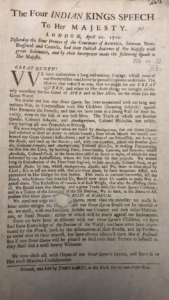 honor at a dinner hosted by the Board of Trade and were privately entertained by William Penn at the Taverne du Diable at Charing Cross. They attended a performance of Powell’s Marionettes at Punch’s Theater; a presentation of Macbeth where they got to sit on the stage. I’m sure the people of the city were quite curious about these “wild men” who had come to their city. Their clothing was so different from the sophisticated garb that was normally seen gracing the royal carriages. Still, the Indians were probably wearing their finest clothing too, and in the New World, it was probably top of the line. The queen wanted to commemorate the diplomatic visit, so the Crown commissioned Jan Verelst to paint the portraits of the Four Kings. These paintings hung in Kensington Palace until 1977, when Queen Elizabeth II had them relocated to the National Archives of Canada. She unveiled them in Ottawa.
honor at a dinner hosted by the Board of Trade and were privately entertained by William Penn at the Taverne du Diable at Charing Cross. They attended a performance of Powell’s Marionettes at Punch’s Theater; a presentation of Macbeth where they got to sit on the stage. I’m sure the people of the city were quite curious about these “wild men” who had come to their city. Their clothing was so different from the sophisticated garb that was normally seen gracing the royal carriages. Still, the Indians were probably wearing their finest clothing too, and in the New World, it was probably top of the line. The queen wanted to commemorate the diplomatic visit, so the Crown commissioned Jan Verelst to paint the portraits of the Four Kings. These paintings hung in Kensington Palace until 1977, when Queen Elizabeth II had them relocated to the National Archives of Canada. She unveiled them in Ottawa.
The four kings were quite a spectacle in London, they were all described in a contemporary pamphlet as being in shape, muscular and within an inch or two of being six feet tall. Their complexions were described as being brown and their hair long and black.” Their visages are very awful and majestick, and their features regular enough, though something of the austere and sullen.” Their faces are covered in art, probably meant to inspire terror during battle. They are described as polite, they will not refuse any drink or food that is offered to them. They loved English beef more than any other kind of food offered to them. The people of London also described them as healthy. “Their health is good, as is proper for primitives; they know no gout, dropsy, gravel, or fevers.”
While I’m sure the big city was awe inspiring for the Kings, they were really there on a mission…to requesting military aid for defense against the French, and the chiefs to ask for missionaries to offset the influence of French Jesuits, who had converted numerous Mohawk to Catholicism. When they met with Queen Anne the court was mourning for the death of the Prince of Denmark, so the four Indian Kings were dressed in all black attire when they met with her. Their address to her was read, they asked for military assistance and missionaries to lead them to “true religion.” After the reading, the chiefs presented the queen with several belts of wampum to signify their meeting. In return for the gifts of the wampum, the queen gave them a set of communion plates, with the royal cipher and coat of arms, for a future Mohawk chapel. (These are now divided between the Mohawk reservations at Brantford, Ontario, and Tyendinaga, near Kingston.) The Archbishop of Canterbury gave each of the chiefs a Bible bound in Turkey-red leather. When she heard their request, Queen Anne informed the Archbishop of Canterbury, Thomas Tenison. They authorized a mission, and Mayor Schuyler 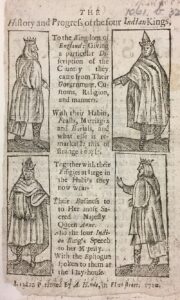 had a chapel built the next year at Fort Hunter (located near the Mohawk “Lower Castle” village) along the Mohawk River. The queen also engaged the four men in conversation through their interpreter, Peter Schuyler’s brother, John. Queen Anne was very generous to the Kings and their people, sending a gift of a silver Communion set and a reed organ. The Mohawk village known as the “Lower Castle” became mostly Christianized village in the early 18th century, unlike the “Upper Castle” at Canajoharie further upriver, where there was no mission founded until 1769, when William Johnson, British agent to the Iroquois, built the Indian Castle Church, which still stands today.
had a chapel built the next year at Fort Hunter (located near the Mohawk “Lower Castle” village) along the Mohawk River. The queen also engaged the four men in conversation through their interpreter, Peter Schuyler’s brother, John. Queen Anne was very generous to the Kings and their people, sending a gift of a silver Communion set and a reed organ. The Mohawk village known as the “Lower Castle” became mostly Christianized village in the early 18th century, unlike the “Upper Castle” at Canajoharie further upriver, where there was no mission founded until 1769, when William Johnson, British agent to the Iroquois, built the Indian Castle Church, which still stands today.
During their visit to London, the Kings were lodged at The Crown and Cushion, in King Street, Covent Garden. Here they slept on beds for the first time and became accustomed to them. Thomas Arne was their host, he was an inn keep and an upholsterer, he was very kind and considerate to his visitors. Because of this, the Indians renamed him Cataraqui in a Mohawk christening ceremony. Cataraqui was the fort that has now become the city of Kingston, Ontario. I’m sure that they really missed those beds when they returned to the New World in May of 1710.
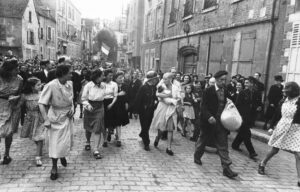 Having a baby is normally a blessed event, but it is also important to be having the baby with the right person. I know that sound like something that is between the man and the woman, and it’s nobody’s business but their own, and I would agree with you on that. However, during World War II, the Nazi regime was so hated that the nations they terrorized didn’t want anything to do with them…so much so that French women having babies with German soldiers were punished by shaving their heads bald and parading them through town. This was done so that everyone would know they betrayed their country, and so they had.
Having a baby is normally a blessed event, but it is also important to be having the baby with the right person. I know that sound like something that is between the man and the woman, and it’s nobody’s business but their own, and I would agree with you on that. However, during World War II, the Nazi regime was so hated that the nations they terrorized didn’t want anything to do with them…so much so that French women having babies with German soldiers were punished by shaving their heads bald and parading them through town. This was done so that everyone would know they betrayed their country, and so they had.
The Nazi regime was set on creating “the perfect race,” in their opinion anyway. They wanted everyone to be light skinned, blond haired, and blue eyed, and those who weren’t had to prove their genetic lines. The Nazis even went so far as to set up places that women (of the right bloodlines) were sent to have their children, conceived with German soldiers. Then, the plan was that they would give their children up for adoption by a Nazi couple who was having trouble conceiving. It was Hitler’s way of preserving the “right” bloodline. Many times, if the woman changed her mind, and wanted to keep the baby, but refused to marry the soldier, their babies were taken from the by force, even if it meant taking their lives. Some of these 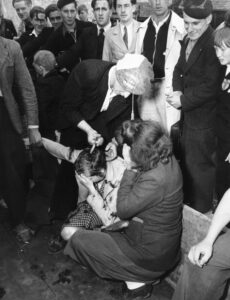 women were in it for the money and had no intention of keeping their babies. They were a simply a “Nazi Baby Machine.”
women were in it for the money and had no intention of keeping their babies. They were a simply a “Nazi Baby Machine.”
Once it was discovered that these women were doing this, they were marked as traitors. Often their own families disowned them. These women might not even be having babies with the Nazi soldiers, just having relations with them. The soldiers saw nothing wrong with hooking up with these women to ply them for information. It was an act of treason on the part of the women. They shouldn’t have allowed themselves to become involved with the Nazi soldiers, because they just had to know that was wrong. Treason is such a dark side of war. Still, there are many dark sides to war, and in most cases, it is the innocent and oppressed that suffer.
The French resistance brought out another dark side to the war, and it was rather brutal, but they felt like it was justified. Looking at it now, I think the beating part was the probably brutal, but maybe still have been justified. Basically, the French Resistance, when women were caught in a physical relationship with a Nazi, shaved their heads, beat the women who had been charged with collaborating with the enemy, and then paraded them around town as a form of punishment. The punishment was followed by harassing the women, with no repercussion for the beatings, head shavings, or the harassing. In France, a woman’s long hair is supposed to be seductive, so shaving their heads, was a way to make them look undesirable. The practice dates back to Biblical times. It was a common punishment for adultery. During the 20th century, it was reintroduced as a means to ridicule women who had physical relationships with the enemy or were prostitutes.  The French Resistance took a page from Bible times, and so it came to pass that during World War II, this act of humiliation was repeated on French women accused of collaborating with the German soldiers. Apart from shaving their heads, they were paraded in the streets, marked with black ink, and even stripped half-naked. At least 20,000 women have been documented to have had their heads shaved. I’m not a proponent of violence, but traitors need to be punished, and after something like that, I would think these women would think twice before getting involved with the Nazi soldiers. and any woman who hadn’t done so, would think twice before even considering such a heinous act.
The French Resistance took a page from Bible times, and so it came to pass that during World War II, this act of humiliation was repeated on French women accused of collaborating with the German soldiers. Apart from shaving their heads, they were paraded in the streets, marked with black ink, and even stripped half-naked. At least 20,000 women have been documented to have had their heads shaved. I’m not a proponent of violence, but traitors need to be punished, and after something like that, I would think these women would think twice before getting involved with the Nazi soldiers. and any woman who hadn’t done so, would think twice before even considering such a heinous act.
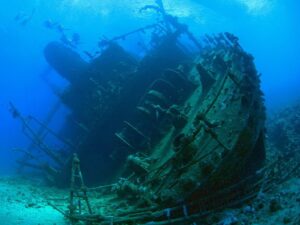 Whenever a ship sinks, it takes with it a lot of gear, personal effects, and sometimes treasures. These days, they send in the submarines, or rather the mini submarines to salvage whatever they can, find out what caused the sinking, and sometimes to aid in raising the ship to the surface. In times past, when a ship went down, it could easily be lost forever, or at least until more modern times when they could finally find it again.
Whenever a ship sinks, it takes with it a lot of gear, personal effects, and sometimes treasures. These days, they send in the submarines, or rather the mini submarines to salvage whatever they can, find out what caused the sinking, and sometimes to aid in raising the ship to the surface. In times past, when a ship went down, it could easily be lost forever, or at least until more modern times when they could finally find it again.
When the Vasa, an amazingly beautiful Swedish warship that sank on its maiden voyage, 1400 yards into its voyage sat in the harbor for years. The did manage to get the cannon from it right away, but everything else sat underwater until the 1950s, when they had a better way to salvage it. When the world’s first completely covered underwater diving suit was invented around 1715, it consisted of an airtight oak barrel. The suit was used mainly for salvage operations of shipwrecks. I wonder what they could have done with Vasa using that. Vasa wasn’t in dangerously deep water, and could have been accessed easily today, but they just didn’t have the equipment.
The cross between a diving bell and standard diving dress is rather interesting. I wonder if the barrel design John Lethbridge used in 1715 was seriously difficult to move in. It reminds me a of a comical space suit, but I guess it served its purpose. However odd it is, it was the first underwater diving suit, and it is currently located in the Cité de la Mer, a maritime museum in Cherbourg, France.
Lethbridge came up with the idea for his diving suit while working for the East India Company as a salvager. The barrel was airtight, so the diver was protected and safe. The barrel was six feet in length, and the diver had little control of it once it was lowered into the water. The diver had to lay flat on his stomach once the barrel. The barrel had two airtight holes on the sides for the diver’s hands and a hole with glass in the front for use as the diver’s viewing window. During trials, Lethbridge demonstrated that the suit enabled divers to stay 12 fathoms (a unit of length equal to six feet) underwater for at least 30 minutes at a time. That was hard for  me to figure out, until I read that once the diver comes out of the water after 30 minutes, the crew pumped fresh air into the suit through a vent using bellows. At the same time, the used air was let out through another vent. Then, with the fact that the barrel was airtight, the diver was good for another 30 minutes. It wasn’t perfect, but it was much further along than salvage operations had been before it. The suit, while odd and very primitive was an immediate success. It was used mostly to retrieve material from shipwrecks. During Lethbridge’s first salvage…the maiden voyage of the diving suit, as it were, Lethbridge recovered 25 chests of silver and 65 cannons! I would call that a definite success.
me to figure out, until I read that once the diver comes out of the water after 30 minutes, the crew pumped fresh air into the suit through a vent using bellows. At the same time, the used air was let out through another vent. Then, with the fact that the barrel was airtight, the diver was good for another 30 minutes. It wasn’t perfect, but it was much further along than salvage operations had been before it. The suit, while odd and very primitive was an immediate success. It was used mostly to retrieve material from shipwrecks. During Lethbridge’s first salvage…the maiden voyage of the diving suit, as it were, Lethbridge recovered 25 chests of silver and 65 cannons! I would call that a definite success.

 My brother-in-law, Brian Cratty has been my sister-in-law, Jennifer Parmely’s partner since July 25, 2011, and theirs has been really a wonderful relationship. They love doing the same things, like skiing, hiking, bicycling, snowshoeing, and hanging out at their cabin on Casper Mountain. They met at Wyoming Medical Center, where they both worked…she as a labor and delivery nurse, and he as a life flight pilot. Brian is retired now, and Jennifer soon will be, so their real adventures are coming up very quickly.
My brother-in-law, Brian Cratty has been my sister-in-law, Jennifer Parmely’s partner since July 25, 2011, and theirs has been really a wonderful relationship. They love doing the same things, like skiing, hiking, bicycling, snowshoeing, and hanging out at their cabin on Casper Mountain. They met at Wyoming Medical Center, where they both worked…she as a labor and delivery nurse, and he as a life flight pilot. Brian is retired now, and Jennifer soon will be, so their real adventures are coming up very quickly.
Brian has been there for Jenifer in so many ways. He has been there for the low points in her life like when her parents passed away; and he has been there for the high points, like hiking Mount Elbert’s 14,473-foot summit. You don’t get more “lows and highs” than that. Through every part of their relationship, Brian has been there to love and support Jennifer, and the rest of the family 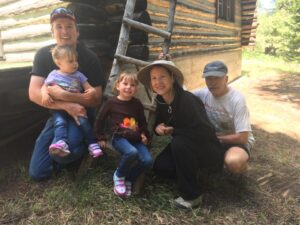 too. We have all grown to love him very much, and look to him as a brother, uncle, grandpa, and dad.
too. We have all grown to love him very much, and look to him as a brother, uncle, grandpa, and dad.
With their birthdays being so close together, Jennifer took this past week off, and the two of them made a trip to Colorado to have some fun…probably skiing, since Colorado had some new snow last week. They really do quite a bit of outdoor activities in Colorado, and I can understand why, because the Rocky Mountains have lots to do…for this fun loving, outdoor couple, even more to do than most people. While traveling is fun, I still think that their favorite place to be is on Casper Mountain at their cabin. It was pretty rustic when they bought it from a friend who, for health reasons, was unable to go there again, and moved to a warmer climate. When they bought it, the cabin was little more than a glorified tent. The interior needed lots of work. Brian and Jennifer have worked really hard to make it into the getaway they want, and I can say that it looks a lot better now. The land around it is much better too, and when they are at the cabin, they are close to some of the trails they love. Brian is probably more of a bicycler than Jennifer is, even though she loves to ride too. He will ride for hours on the mountain trails. Sometimes when the rest of the 
 family are hiking, they cross paths with Brian on his bicycle.
family are hiking, they cross paths with Brian on his bicycle.
Brian is a licensed pilot, and I sometimes wonder if he misses that part of his life. I know he could fly planes for people if he wanted to, but that would put him on someone else’s timeline again, and that is something most of us retired people don’t want to do. So, Brian spends his time doing the things he loves, and that suits him just fine. Today is Brian’s birthday. Happy birthday Brian!! Have a great day!! We love you!!

 In a time of world chaos, one thing stands out…Jesus. We all need Jesus. It’s hard to believe that a sinless man would be willing to carry the sins of the world. None of us could or would do that. We would most likely fear death too much…at least at such a young age. It is believed that Jesus was about 33 years old. Most of us would feel like we had too much to live for at that age, and yet, Jesus endured the scourging, the “trial” that was nothing more than a lynch mob, and the horrible suffocating death on the cross, because He saw joy set before Him…JOY, how could that be? How could Jesus see the torture and death that was coming to Him as joy, because mankind could still come to Heaven…that was His joy.
In a time of world chaos, one thing stands out…Jesus. We all need Jesus. It’s hard to believe that a sinless man would be willing to carry the sins of the world. None of us could or would do that. We would most likely fear death too much…at least at such a young age. It is believed that Jesus was about 33 years old. Most of us would feel like we had too much to live for at that age, and yet, Jesus endured the scourging, the “trial” that was nothing more than a lynch mob, and the horrible suffocating death on the cross, because He saw joy set before Him…JOY, how could that be? How could Jesus see the torture and death that was coming to Him as joy, because mankind could still come to Heaven…that was His joy.
He saw the joy of a world that could be back in right standing with God. Something we could never have achieved on our own. This world was in a seriously horrible place…even more so than the chaos we are in right now. The wages of sin is death, and we had all sinned. It was going to take the death of a man to pay for the sins of the world, but that man had to be sin-free. In the beginning, a sinless man sinned, thereby giving away his birthright of eternal life. So that meant either all mankind had to die and go to Hell, or a sinless man had to die to pay the price for all of us. Enter Jesus, and thank God He was willing to pay that price for us.
That was what Jesus did for us when He went to the cross on Good Friday. I don’t know if many of you really know what scourging is, but let me tell you. The Romans were famous for their horrific types of torture. The “whip” they used to beat (scourge) Jesus usually had nails or pieces of metal or glass attached to them. The purpose of these things being attached to the whips tails was to rip the flesh off of the victim. By the time they were done, internal organs were often visible. Then they took Jesus, after making Him carry His own cross, and nailed Him to that cross. The way they nailed Him to the cross meant that He had to push up with His feet to be able to get air into His lungs. The more tired the victim became, the less they would be able to raise themselves up so they could breathe. It was a matter of slow suffocation. That was what Jesus endured to give us the opportunity to have eternal life again. Nevertheless, it was and is still our choice. I just can’t imagine how anyone could choose not to receive that totally free gift of God. I know I will not refuse that gift.

 After being in the grave for three days, Jesus arose from the dead triumphant with the victory, and the keys to the kingdom, which He gave back to us. We can have it all…because He lives. He is risen!! He is alive!! And because Jesus lives, I can face tomorrow, no matter how ugly this world looks today. Victory is mine!! Heaven belongs to me!! I am free, because Jesus paid the price for me…and for you too…should you choose to receive. Praise God…Jesus is risen!! Happy Resurrection Day everyone!!
After being in the grave for three days, Jesus arose from the dead triumphant with the victory, and the keys to the kingdom, which He gave back to us. We can have it all…because He lives. He is risen!! He is alive!! And because Jesus lives, I can face tomorrow, no matter how ugly this world looks today. Victory is mine!! Heaven belongs to me!! I am free, because Jesus paid the price for me…and for you too…should you choose to receive. Praise God…Jesus is risen!! Happy Resurrection Day everyone!!
 There are all kinds of records, but some are just stranger than others. Switzerland actually holds a strange record…for attacking its neighbor, Liechtenstein. This is particularly odd in that Switzerland is a neutral nation…very opposed to war!! In fact, Switzerland is the longest standing neutral nation in the world and has not taken part in a “war” since 1505. Its official stance of non-involvement had been decided during The Congress of Vienna in 1815, in which major European leaders met to discuss the nature of Europe after the defeat of Napoleon. Nevertheless, they do have an army.
There are all kinds of records, but some are just stranger than others. Switzerland actually holds a strange record…for attacking its neighbor, Liechtenstein. This is particularly odd in that Switzerland is a neutral nation…very opposed to war!! In fact, Switzerland is the longest standing neutral nation in the world and has not taken part in a “war” since 1505. Its official stance of non-involvement had been decided during The Congress of Vienna in 1815, in which major European leaders met to discuss the nature of Europe after the defeat of Napoleon. Nevertheless, they do have an army.
Diplomatic and economic relations between Switzerland and Liechtenstein have been good. In fact, you could say relations were very good, with Switzerland accepting the role of safeguarding the interests of its tiny next-door neighbor. Liechtenstein has an embassy in Bern, Switzerland, and Switzerland is accredited to Liechtenstein from its Federal Department of Foreign Affairs in Bern and maintains an honorary consulate in Vaduz, Liechtenstein. The two countries also share an open border, mostly along the Rhine, but also in the Rätikon range of the Alps, between the Fläscherberg and the Naafkopf.
With all that “good will” between the nations, you would never expect conflict, but apparently, Switzerland has 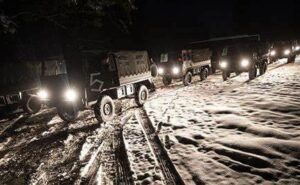 attacked Liechtenstein three times in 30 years. Of course, it was by mistake each time! How does that happen? Nevertheless, it did. The first time was probably the only “aggressive” accident of the bunch. On December 5, 1985, during an artillery exercise, the Swiss Army had launched munitions in the middle a winter storm. The wind took the munitions way off course, into the Bannwald Forest of Liechtenstein, and started a forest fire. No one was injured and the Liechtenstein government was very angry. Switzerland had to pay a heavy penalty for the environmental damage caused. The second attack took place on October 13, 1992. The Swiss Army received orders to set up an observation post in Treisenberg. They followed the orders and marched to Treisenberg. What they didn’t realize was that Treisenberg lies within the territory of Liechtenstein. They marched into Treisenberg with rifles and only later realized that they were in Liechtenstein. The last attack was on March 1, 2007. A group of Swiss Army infantry soldiers was in training when the weather took a bad turn. There was heavy rainfall, and the soldiers were not carrying any GPS or compass. Eventually, they ended up in Liechtenstein! Switzerland apologized to the Liechtenstein government for the intrusion, yet again.
attacked Liechtenstein three times in 30 years. Of course, it was by mistake each time! How does that happen? Nevertheless, it did. The first time was probably the only “aggressive” accident of the bunch. On December 5, 1985, during an artillery exercise, the Swiss Army had launched munitions in the middle a winter storm. The wind took the munitions way off course, into the Bannwald Forest of Liechtenstein, and started a forest fire. No one was injured and the Liechtenstein government was very angry. Switzerland had to pay a heavy penalty for the environmental damage caused. The second attack took place on October 13, 1992. The Swiss Army received orders to set up an observation post in Treisenberg. They followed the orders and marched to Treisenberg. What they didn’t realize was that Treisenberg lies within the territory of Liechtenstein. They marched into Treisenberg with rifles and only later realized that they were in Liechtenstein. The last attack was on March 1, 2007. A group of Swiss Army infantry soldiers was in training when the weather took a bad turn. There was heavy rainfall, and the soldiers were not carrying any GPS or compass. Eventually, they ended up in Liechtenstein! Switzerland apologized to the Liechtenstein government for the intrusion, yet again.
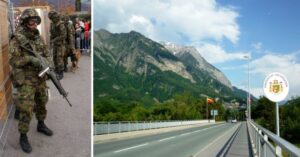
Thankfully these “accidental” attacks were not of a deadly nature. They were really more a “comedy of errors” than an attack. Thankfully, the people of Liechtenstein saw the “attacks” for what they were, and tended to care for their “intruders,” rather than fight back. Of course, that would have been difficult too, since Liechtenstein does not have an army of their own, and so depended on the “protection” of their neighbors…when they didn’t accidentally attack them.
 The Olympics…the dream of every serious athlete. While most of us will never get there, but many of us love to watch the best of the best athletes vie for the world title of Olympic Gold. These athletes would do just about anything to win. The men’s marathon in the 1904 Olympic Games was no exception.
The Olympics…the dream of every serious athlete. While most of us will never get there, but many of us love to watch the best of the best athletes vie for the world title of Olympic Gold. These athletes would do just about anything to win. The men’s marathon in the 1904 Olympic Games was no exception.
This race might have been the strangest race in history…going forward or backward. Only a few of the runners had any experience in running a race…much less a marathon, and the others were…well, “oddities” to say the least. That marathon was more of a comedy show than a serious race. The runners consisted of ten Greeks who had never run a marathon. Two of these belonged to the Tsuana tribe of South Africa and arrived barefoot to the race, and one competitor was a Cuban mailman who wore street clothing to the race. These days, they would almost be laughed off the track. I can just hear the shocked voices throughout the crowd at that race.

If you thought the apparel was odd…well hold on to your horses, because the “level of strange” is just getting started. The first to complete the race was American runner named Fred Lorz. Apparently, Lorz had dropped out of the race after nine miles and then hitch-hiked in a car. When the car broke down at the 19th mile, he jogged to the finish line. He was disqualified and banned from the competition for life. Sounds fair to me. The second to arrive, and the champion with Lorz disqualification, was Thomas Hicks. Ten miles from the finish line, he had almost given up, but his trainers urged him to continue. Still, it was an enormous struggle. He was given several doses of strychnine, a common rat poison, to help get him to the end of the race…WHAT!! When he reached the stadium, his trainers and supporters carried him to the finish line! It’s a wonder their “energy 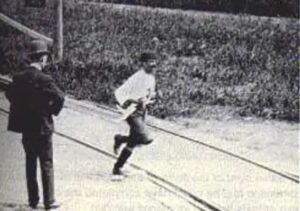 boost” didn’t kill him!! Even though he got the gold medal that time, he never ran professionally again. A Cuban postman named Andarín Carvajal, ran the race in street clothes. To top it off, he had not eaten in 40 hours. Before a race!! Are you kidding me!! He got hungry and took a detour into an apple orchard during the race. He ate some rotten apples that gave him stomach cramps. Despite falling ill, he managed to finish in the fourth place!! Where were all the other racers, while he was taking his dinner break? If you ask me, this had to be the strangest marathon ever. It was almost like they were making it up as they went along.
boost” didn’t kill him!! Even though he got the gold medal that time, he never ran professionally again. A Cuban postman named Andarín Carvajal, ran the race in street clothes. To top it off, he had not eaten in 40 hours. Before a race!! Are you kidding me!! He got hungry and took a detour into an apple orchard during the race. He ate some rotten apples that gave him stomach cramps. Despite falling ill, he managed to finish in the fourth place!! Where were all the other racers, while he was taking his dinner break? If you ask me, this had to be the strangest marathon ever. It was almost like they were making it up as they went along.
 Charles Joughin had to figure that he was one of the most fortunate people on earth in 1912. Joughin was a British-American chef who had just landed a job as the chief baker on the greatest ship there was at the time…Titanic. Charles Joughin was born on Patten Street, next to the West Float in Birkenhead, England, on August 3, 1878. His parents were John Edwin (1846–1886)…a licensed victualer (a British person who is licensed to sell alcoholic liquor), and Ellen (Crombleholme) Joughin (1850–1938). He was enamored with the sea his whole young life, and he first went to sea in 1889 at age 11. He went on to become chief baker on various White Star Line steamships, notably the RMS Olympic, Titanic’s sister ship.
Charles Joughin had to figure that he was one of the most fortunate people on earth in 1912. Joughin was a British-American chef who had just landed a job as the chief baker on the greatest ship there was at the time…Titanic. Charles Joughin was born on Patten Street, next to the West Float in Birkenhead, England, on August 3, 1878. His parents were John Edwin (1846–1886)…a licensed victualer (a British person who is licensed to sell alcoholic liquor), and Ellen (Crombleholme) Joughin (1850–1938). He was enamored with the sea his whole young life, and he first went to sea in 1889 at age 11. He went on to become chief baker on various White Star Line steamships, notably the RMS Olympic, Titanic’s sister ship.
Joughin married Louise Woodward (born 11 July 1879), a native of Douglas, Isle of Man, on November 17, 1906, in Liverpool, England. They had a daughter, Agnes Lillian, in 1907, and a son, Roland Ernest, in 1909. It is believed that Louise died from complications in childbirth around 1919. Their new son, Richard, was also lost. It was a low point in his life.
As we all know, the job Joughin landed on the Titanic was going to prove to be a disaster. When the ship hit an iceberg on the evening of April 14th, at 11:40pm, Joughin was off duty. He was in his bunk when he felt the shock of the collision and immediately got up. He knew that this could not be good. Word was being passed down from the upper decks that officers were getting the lifeboats ready for launching. Joughin sent his thirteen men up to the boat deck with provisions for the lifeboats…four loaves of bread apiece, about forty pounds of bread. Joughin stayed behind for a time, but then followed them, reaching the Boat Deck at around 12:30am, he then helped with the evacuation.
Once on deck, Joughin joined Chief Officer Henry Tingle Wilde by Lifeboat 10. Joughin and the stewards and other seamen began helping the ladies and children through the crowd of people to the lifeboat. Sadly, many of the women were more afraid of the lifeboats than they were the sinking Titanic. They began to run away, saying that they were safer aboard the Titanic than in the tiny boats being tossed in the waves. Leaving him no choice, the Chief Baker then went on to A Deck and forcibly brought up women and children, throwing them into the lifeboat.
Joughin had been assigned as captain of Lifeboat 10, but he did not board the boat, because it was already being crewed by two sailors and a steward. After Lifeboat 10 was launched, Joughin went below, and “had a drop of liqueur” in his quarters, which was in reality a tumbler half-full of whiskey, as he later specified. Joughin was sure that he would not be one of the people allowed onboard a lifeboat, because there were simply not enough lifeboats to hold all the people onboard Titanic. After his drink, Joughin came upstairs again, after meeting “the old doctor,” assumedly William O’Loughlin. This was quite possibly the last time anyone ever saw 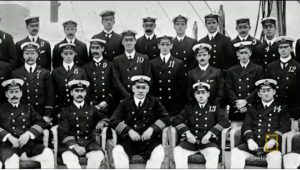 O’Loughlin. When Joughin arrived back at the Boat Deck, the rushing for boats had ended, because all the boats had been lowered. He then went down into the A Deck promenade and threw about fifty deck chairs overboard so that they could be used as flotation devices, by the unfortunate ones who could not get into a boat.
O’Loughlin. When Joughin arrived back at the Boat Deck, the rushing for boats had ended, because all the boats had been lowered. He then went down into the A Deck promenade and threw about fifty deck chairs overboard so that they could be used as flotation devices, by the unfortunate ones who could not get into a boat.
Joughin then went into the deck pantry on A Deck, for a drink of water. Suddenly, he heard a loud crash, “as if part of the ship had buckled” and indeed it had. He left the pantry and joined the crowd running aft toward the poop deck. As he was crossing the well deck, the ship suddenly gave a list over to port and, according to him, threw everyone in the well in a pile except for him. Joughin climbed to the starboard side of the poop deck, and hoisted himself over the safety rail, so that he was on the outside of the ship as it went down by the head. As the ship went down in a vertical position at 2:20am on April 15, 1912, Joughin rode it down as if it were an elevator, somehow managing not to get his head under the water. He said his head “may have been wetted, but no more.” So it was that Joughin was the last survivor to leave the Titanic. Now began his real ordeal.
Joughin testified that he kept paddling and treading water for about two hours. He also admitted to hardly feeling the cold, which he credited to the whiskey he drank. When daylight broke, he spotted the upturned Collapsible B lifeboat, with Second Officer Charles Lightoller and around 30 men standing on the side of the boat. Joughin slowly swam towards it, but there was no room for him. Cook Isaac Maynard, recognized him and held his hand as the Chief Baker held onto the side of the boat, with his feet and legs still in the water. A short time later, another lifeboat appeared and Joughin swam to it. He was taken in, where he stayed until he boarded the RMS Carpathia that had come to their rescue. Miraculously, he was rescued from the sea with only swollen feet. He survived the ship’s sinking, becoming notable for having survived in the frigid water for an exceptionally long time before being pulled onto the overturned Collapsible B lifeboat with virtually no ill effects. It is estimated that he was in the water for about four hours.
After surviving the Titanic disaster, Joughin returned to England, and was one of the crew members who reported to testify at the British Wreck Commissioner’s inquiry into the sinking headed by Lord Mersey. In 1920, Joughin moved permanently to the United States to Paterson, New Jersey. According to his obituary he was also on board the SS Oregon when it sank in Boston Harbor in 1886. He also served on American Export 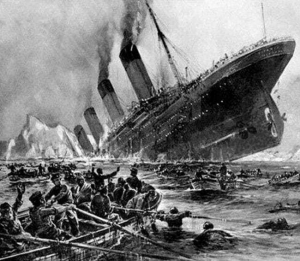 Lines ships and on World War II troop transports before retiring in 1944.
Lines ships and on World War II troop transports before retiring in 1944.
After moving to New Jersey, he remarried to Mrs Annie Eleanor (Ripley) Howarth Coll (born December 29, 1870), a native of Leeds, who had first come to the USA in 1888. Annie was twice widowed twice and had a daughter named Rose, who was born in 1891. Annie’s death in 1943 was a great loss from which he never recovered. Twelve years later, Joughin was invited to describe his experiences in a chapter of Walter Lord’s book, A Night to Remember. Soon afterwards, his health rapidly declined. He died in a Paterson hospital on December 9, 1956, at the age of 78, after battling pneumonia for two weeks. He was buried by his wife in the Cedar Lawn Cemetery, in Paterson, New Jersey.

 These days, people can buy a ticket to ride a train and have a private room with a bed and bathroom in it to make their trip more comfortable. Since I have taken a train trip from Seattle, Washington to Chicago, Illinois, I can tell you that paying the extra money for that private cabin is really a good idea. We traveled in in a seat among the other passengers, and while the seat was pretty comfortable, it was not comfortable to sleep in. My parents traveled on the Amtrack too, and they did get a private cabin, so their experience was probably much better than mine, although I loved the trip…just not the sleeping part of it. Of course, even with the comfort my parents had on
These days, people can buy a ticket to ride a train and have a private room with a bed and bathroom in it to make their trip more comfortable. Since I have taken a train trip from Seattle, Washington to Chicago, Illinois, I can tell you that paying the extra money for that private cabin is really a good idea. We traveled in in a seat among the other passengers, and while the seat was pretty comfortable, it was not comfortable to sleep in. My parents traveled on the Amtrack too, and they did get a private cabin, so their experience was probably much better than mine, although I loved the trip…just not the sleeping part of it. Of course, even with the comfort my parents had on 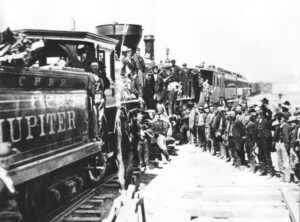 their trip, it was nothing compared to the Gilded Age, when the very rich had their own car on the train.
their trip, it was nothing compared to the Gilded Age, when the very rich had their own car on the train.
The Gilded Age was a time when the very rich went to great lengths to let all of the “less fortunate ones” know that they had wealth. The Gilded Age took place mostly from 1887 to 1900, with some earlier exceptions. One of the main objectives of life during the Gilded Age, if one could afford it, was to see and be seen in the most luxurious ways possible, and the railway was no different. Commercial air travel didn’t exist then, and cars were very slow. So, when the nation came into the age of the rails, the wealthy made sure that extreme luxury there was no exception. By the 1870s, private railroad cars…some extravagantly decorated…were the most fashionable way to travel. I suppose it would have been like the very 
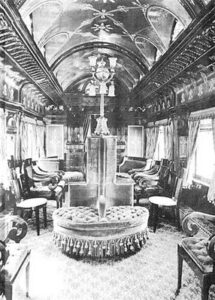 rich on ships, but they could stay a little closer to home, and still travel. The people would never travel in humble wooden coach seats, which I can understand, but most people had no other choice. Money bought comfort.
rich on ships, but they could stay a little closer to home, and still travel. The people would never travel in humble wooden coach seats, which I can understand, but most people had no other choice. Money bought comfort.
With great fanfare, the very rich boarded their own entire rail cars, where the walls were lined in velvet, the upholstery plush, and the decor much like that of a fancy parlor at home. The private cars had bedrooms, running water, and a private water closet. Now expense was spared to make sure that the wealthy car owner was never out of the lap of luxury. It seems like a cruel way to act, but I suppose it is simply the way it is.

 My sister-in-law, Jennifer Parmely is a busy person in just about every way. Jennifer is a labor and delivery nurse who is close to retirement. I sometimes find myself amazed that she can possible have been helping to deliver babies for about 40 years now. She has assisted in the delivery of more babies than I’m sure even she knows or could count. It’s a lot of years of deliveries, some of which were her own grandnieces and grandnephews. I know that my girls, Corrie Petersen and Amy Royce were both very thankful to have their aunt in the room with them when they gave birth, and so was I. It’s hard to watch your kids go through so much pain, and it is comforting to know that their aunt, who was a delivery room nurse, and who cared about my kids, was there with them during one of the hardest times in their lives, even if they were also the happiest moments of their lives. Jennfer has been that blessing to so many people, friends, family, and strangers, and all of them are so thankful.
My sister-in-law, Jennifer Parmely is a busy person in just about every way. Jennifer is a labor and delivery nurse who is close to retirement. I sometimes find myself amazed that she can possible have been helping to deliver babies for about 40 years now. She has assisted in the delivery of more babies than I’m sure even she knows or could count. It’s a lot of years of deliveries, some of which were her own grandnieces and grandnephews. I know that my girls, Corrie Petersen and Amy Royce were both very thankful to have their aunt in the room with them when they gave birth, and so was I. It’s hard to watch your kids go through so much pain, and it is comforting to know that their aunt, who was a delivery room nurse, and who cared about my kids, was there with them during one of the hardest times in their lives, even if they were also the happiest moments of their lives. Jennfer has been that blessing to so many people, friends, family, and strangers, and all of them are so thankful.
Jennifer is also an athlete. She hikes, skis, rides bicycles, and also does many indoor forms of exercise there is. 
 Jennifer and her partner, Brian Cratty have a cabin on Casper Mountain, so they can be closer to the mountain and activities they love. For them, Casper Mountain is their “happy place.” Jennifer and Brian have hiked many places, including to heights as high as 14,473 feet when they climbed Mount Elbert in Colorado, called a 14er. She has also hiked in Vermont, Maine, and New Zealand…yes, New Zealand. That is a dedicated hiker, and I thought I was. Not nearly as much as Jennifer. I think when Jennifer retires, she will wonder how she had time to work with all of her athletic passions.
Jennifer and her partner, Brian Cratty have a cabin on Casper Mountain, so they can be closer to the mountain and activities they love. For them, Casper Mountain is their “happy place.” Jennifer and Brian have hiked many places, including to heights as high as 14,473 feet when they climbed Mount Elbert in Colorado, called a 14er. She has also hiked in Vermont, Maine, and New Zealand…yes, New Zealand. That is a dedicated hiker, and I thought I was. Not nearly as much as Jennifer. I think when Jennifer retires, she will wonder how she had time to work with all of her athletic passions.
While being a nurse, an athlete, as well as mom of three boys, Barry Schulenberg (married to Kellie), JD Parmely, and Eric Parmely (married to Ashley), keeps Jennifer quite busy, her latest blessings are her grandchildren. Jennifer has three granddaughters, Reagan, Hattie, and Maeve Parmely, and grandson Bowen 
 Parmely…these are the children on her son Eric and his wife Ashley. Jennifer loves to do special things for the kids, like their own special cake for their birthday, taking them on a special shopping trip for their birthdays, and taking turns spending the night with their grandparents. She works hard to make things special for each of them. Jennifer goes by Oma to the kids, which is German for Grandma…a fitting name for a woman of German descent (along with a lot of English). For Jennifer, life is good. Today is Jennifer’s birthday. Happy birthday Jennifer!! Have a great day!! We love you!!
Parmely…these are the children on her son Eric and his wife Ashley. Jennifer loves to do special things for the kids, like their own special cake for their birthday, taking them on a special shopping trip for their birthdays, and taking turns spending the night with their grandparents. She works hard to make things special for each of them. Jennifer goes by Oma to the kids, which is German for Grandma…a fitting name for a woman of German descent (along with a lot of English). For Jennifer, life is good. Today is Jennifer’s birthday. Happy birthday Jennifer!! Have a great day!! We love you!!

